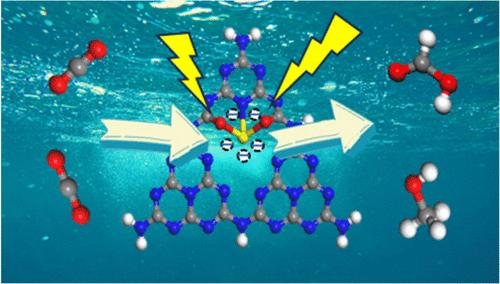Our official English website, www.x-mol.net, welcomes your
feedback! (Note: you will need to create a separate account there.)
Transition Metals Doped into g-C3N4 via N,O Coordination as Efficient Electrocatalysts for the Carbon Dioxide Reduction Reaction
Langmuir ( IF 3.7 ) Pub Date : 2024-11-14 , DOI: 10.1021/acs.langmuir.4c03938 Haoyang Qiu, Huohai Yang, Peng Wang, Manxi Leng, Xingbo Ge, Xu Yang, Xin Chen
Langmuir ( IF 3.7 ) Pub Date : 2024-11-14 , DOI: 10.1021/acs.langmuir.4c03938 Haoyang Qiu, Huohai Yang, Peng Wang, Manxi Leng, Xingbo Ge, Xu Yang, Xin Chen

|
The electrochemical carbon dioxide reduction reaction (CO2RR) is a potential and efficient method that can directly convert CO2 into high-value-added chemicals under mild conditions. Owing to the exceptionally high activation barriers of CO2, catalysts play a pivotal role in CO2RR. In this study, the transition metal (TM = Sc, Ti, V, Cr, Mn, Fe, Co, Ni, Cu, and Zn) is doped into g-C3N4 with a unique N,O-coordination environment, namely, TM–N1O2/g-C3N4. Herein, the catalytic performance and reaction mechanism for the CO2RR on TM–N1O2/g-C3N4 are systematically investigated by density functional theory methods. Especially, through the calculation of ΔG*H and ΔG*COOH/ΔG*OCHO, the catalysts with preference for the CO2RR over the hydrogen evolution reaction (HER) are selected for further study. Furthermore, Gibbs free energy computation results of each elementary step for the CO2RR on these catalysts indicate that Ti–N1O2/g-C3N4 has significant catalytic activity and selectivity for reducing CO2 to methanol (CH3OH) with the limiting potential (UL) of −0.55 V. Finally, through frontier molecular orbital theory and charge transfer analyses, the introduction of the O atoms illustrates that it is instrumental in regulating the electron distribution of the catalytic active site, thereby improving the catalytic performance. This work provides insight into the design of single-atom catalysts with unique coordination structures for the CO2RR.
中文翻译:

通过 N,O 配位掺杂 g-C3N4 的过渡金属作为二氧化碳还原反应的高效电催化剂
电化学二氧化碳还原反应 (CO2RR) 是一种潜力大且有效的方法,可以在温和的条件下直接将 CO2 转化为高附加值的化学品。由于 CO2 具有极高的活化阻垒性,催化剂在 CO2RR 中起着关键作用。在本研究中,过渡金属(TM = Sc、Ti、V、Cr、Mn、Fe、Co、Ni、Cu 和 Zn)被掺杂到 g-C3N4 中,具有独特的 N,O 配位环境,即 TM-N1O2/g-C3N4。本文通过密度泛函理论方法系统研究了 CO2RR 对 TM–N1O2/g-C3N4 的催化性能和反应机理。特别是,通过计算 ΔG*H 和 ΔG*COOH/ΔG*OCHO,选择优先使用 CO2RR 而不是析氢反应 (HER) 的催化剂进行进一步研究。此外,这些催化剂上 CO 2RR 的每个基本步骤的吉布斯自由能计算结果表明,Ti–N1O2/g-C3N4 具有显着的催化活性和选择性,可将 CO2 还原为具有极限电位 (UL 的甲醇3 OH)) 为 −0.55 V。最后,通过前沿分子轨道理论和电荷转移分析,O 原子的引入表明它有助于调节催化活性位点的电子分布,从而提高催化性能。 这项工作为设计具有独特配位结构的 CO2RR 单原子催化剂提供了见解。
更新日期:2024-11-14
中文翻译:

通过 N,O 配位掺杂 g-C3N4 的过渡金属作为二氧化碳还原反应的高效电催化剂
电化学二氧化碳还原反应 (CO2RR) 是一种潜力大且有效的方法,可以在温和的条件下直接将 CO2 转化为高附加值的化学品。由于 CO2 具有极高的活化阻垒性,催化剂在 CO2RR 中起着关键作用。在本研究中,过渡金属(TM = Sc、Ti、V、Cr、Mn、Fe、Co、Ni、Cu 和 Zn)被掺杂到 g-C3N4 中,具有独特的 N,O 配位环境,即 TM-N1O2/g-C3N4。本文通过密度泛函理论方法系统研究了 CO2RR 对 TM–N1O2/g-C3N4 的催化性能和反应机理。特别是,通过计算 ΔG*H 和 ΔG*COOH/ΔG*OCHO,选择优先使用 CO2RR 而不是析氢反应 (HER) 的催化剂进行进一步研究。此外,这些催化剂上 CO 2RR 的每个基本步骤的吉布斯自由能计算结果表明,Ti–N1O2/g-C3N4 具有显着的催化活性和选择性,可将 CO2 还原为具有极限电位 (UL 的甲醇3 OH)) 为 −0.55 V。最后,通过前沿分子轨道理论和电荷转移分析,O 原子的引入表明它有助于调节催化活性位点的电子分布,从而提高催化性能。 这项工作为设计具有独特配位结构的 CO2RR 单原子催化剂提供了见解。


















































 京公网安备 11010802027423号
京公网安备 11010802027423号